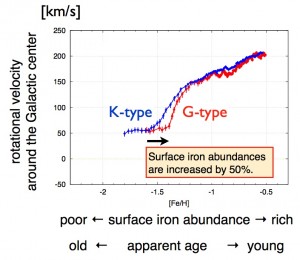Are stars putting on makeup? Stellar surface iron abundances enhanced by metal accretion from surrounding gas

The amount of iron in the Universe has been growing monotonically ever since the Big Bang. Because stars are formed from the gas that exists throughout space, those formed early in the early Universe tend to have lower iron abundances than those formed more recently. Until now it was thought that the iron abundance in the stellar surface was fixed at birth and did not change from that “congenital” value, and this value has long been used as a standard for calculating the age of stars. On the other hand it has also been proposed that the iron abundance in the stellar surface of originally iron-poor stars may increase as a result of metal accretion due to collision with and incorporation of iron-rich gas, making them appear younger than they are. However, to date it had not been possible to test this hypothesis observationally.

© Kohei Hattori.
Correlation between the rotational velocity around the Galactic center and the stellar surface iron abundance (Fe/H). The correlations for G-type (red) and K-type main-sequence stars (blue) should be identical if metal accretion onto their surfaces can be neglected. The observed offset (black arrow) indicates the extent to which metal accretion has enhanced the surface iron abundances of G-type main-sequence stars, or to which they look younger than they really are.
Now, an international team of researchers led by the University of Tokyo Graduate School of Science and the United States National Optical Astronomical Observatory tested the above hypothesis by analyzing the orbital motion and surface iron concentration of nearly 10,000 main-sequence stars (stars that convert hydrogen to helium in their cores and release the heat generated as light) in our Milky Way galaxy. The researchers discovered that it is possible that some of the main-sequence stars in the Milky Way halo had increased iron abundances in the stellar surface, as predicted by the hypothesis.
This discovery that some stars may appear younger than they are suggests a limitation of current methods of estimating stellar age based on prevailing theory and indicates the need to reconsider the contemporary view of the history of the Milky Way, and may require reconsideration of theories concerning the birth of first generation stars in the early Universe.
Press release (Japanese)
Paper
Kohei Hattori, Yuzuru Yoshii, Timothy C. Beers, Daniela Carollo, Young Sun Lee,
“Possible Evidence for Metal Accretion onto the Surfaces of Metal-Poor Main-Sequence Stars”,
The Astrophysical Journal Online Edition: 2014/3/18, doi: 10.1088/0004-637X/784/2/153.
Article link






